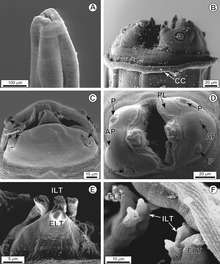Physalopteridae
Physalopteridae is a family of spirurian nematodes,[1] which belongs to the superfamily Physalopteroidea. Like all nematodes, they have neither a circulatory nor a respiratory system.
| Physalopteridae | |
|---|---|
 | |
| Physaloptera ngoci, Scanning electron microscopy | |
| Scientific classification | |
| Kingdom: | |
| Phylum: | |
| Class: | |
| Order: | |
| Superfamily: | Physalopteroidea |
| Family: | Physalopteridae Railliet, 1893 |
| Genera | |
|
see text | |
The Physalopteridae include species which are parasitic in various vertebrates.
Systematics
- Subfamily Physalopterinae Railliet, 1893
- Genus Physaloptera Rudolphi, 1819
- Subfamily Proleptinae Schulz, 1927
References
- Railliet, A. (1893). Traité de Zoologie Médicale et Agricole. Deuxième Édition. Asselin et Houzeau, Paris
- Bezerra, T.N.; Decraemer, W.; Eisendle-Flöckner, U.; Holovachov, O.; Leduc, D.; Miljutin, D.; Sharma, J.; Smol, N.; Tchesunov, A.; Mokievsky, V.; Venekey, V.; Vanreusel, A. (2018). NeMys: World Database of Free-Living Marine Nematodes. Physalopteridae Railliet, 1893. Accessed through: World Register of Marine Species at: http://marinespecies.org/aphia.php?p=taxdetails&id=22839 on 2018-08-06
- Moravec, František; Justine, Jean-Lou (2018). "Rasheedia n. nom. (Nematoda, Physalopteridae) for Bulbocephalus Rasheed, 1966 (a homonym of Bulbocephalus Watson, 1916), with description of Rasheedia heptacanthi n. sp. and R. novaecaledoniensis n. sp. from perciform fishes off New Caledonia". Parasite. 25: 39. doi:10.1051/parasite/2018033. ISSN 1776-1042. PMC 6063723. PMID 30052500.

This article is issued from Wikipedia. The text is licensed under Creative Commons - Attribution - Sharealike. Additional terms may apply for the media files.